![]()
![]()
![]()
Use LEFT and RIGHT arrow keys to navigate between flashcards;
Use UP and DOWN arrow keys to flip the card;
H to show hint;
A reads text to speech;
273 Cards in this Set
- Front
- Back
- 3rd side (hint)
|
Ball wall squat : |

Back (Definition) |
|
|
|
Resistance can also come in the form of elasticity through the use of |
Tubing & bands. |
|
|
|
Strength training machines are a good resistance training method for |
New clients. |
|
|
|
Strength training machines offer those new to exercise a |
Safer & effective option to freeways. |
|
|
|
Machines tend to keep the individual in a |
Fixed plane of motion. |
|
|
|
Using a machine and staying in a fixed plane of motion limits |
Excessive ROM that may result in unnecessary musculoskeletal stress. |
|
|
|
Strength training machines may also be the strength modality of choice for those who |
Lacks stability or have other functional limitations |
The elderly use Machines more. |
|
|
Strength training machines allow individuals to change the |
Load rather quickly with a simple pull of a pin or turn of the dial. |
|
|
|
Strength machines are generally regarded as inferior to free weights for improving |
Core stability & neuromuscular efficiency (proper movement patterns) |
|
|
|
Strength training machines offer artificial |
Support versus one’s core musculature providing stability. |
|
|
|
Machines often times fail to accommodate |
Multi joint movements that incorporate the use of both the upper/lower extremities simultaneously. |
|
|
|
Not all strength-training machines are designed to fit all |
Body types, limiting the effectiveness of exercise, possibly creating more stress to the joints. |
|
|
|
Machines primarily work in one |
Plane of motion & can limit one’s ability to develop strength in all planes. |
|
|
|
A client beginning by performing a chest press machine during their initial week of training to become acclimated to resistance exercise will then progress to progressing from a chest press machine to a dumbbell chest press puts an individual in a new |
Dumbbell chest press. |
|
|
|
Progressing from a chest press machine to a dumbbell chest press puts an individual in a new |
Position (supine). |
|
|
|
Do use of dumbbells forces the individual to have to |
Stabilize their self on the bench through their core muscles, creating greater demand on the shoulder stability to handle. |
|
|
|
The progression from a dumbbell chest press would be |
A stability ball dumbbell chest press. |
|
|
|
Progression from chest press machine : |

Back (Definition) |
|
|
|
Pros and cons of strength machines & free weights : |
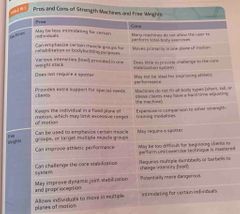
Back (Definition) |
|
|
|
Free weights allow for individuals to perform exercises in |
All planes of motion (sagittal, transfers, frontal) |
|
|
|
Free weights can be used with various degrees of |
Amplitude & ROM consistent with those experienced in daily life & sports. |
|
|
|
Combining all of these emotions use during free weights will |
Motor learning & improve overall NM efficiency & performance. |
|
|
|
Free weight exercises can be easily progressed from |
Bilateral see you in a lateral movements. |
|
|
|
When free weight exercises are progressed what do they provide? |
A greater demand on core stability & proprioception. |
|
|
|
The dumbbell chest press exercise can be progressed from |
Two-arms, to alternating arms, to one arm. |
|
|
|
Relay exercises allow individuals to perform ___ movements incorporating the entire ___. |
Multijoint (complex) Kinetic chain |
|
|
|
Performing complex exercises requires more |
Energy, enabling individuals to expand more calories in a shorter period. |
This type of exercise is ideal for individuals seeking alterations in body comp. |
|
|
Free weights are a great way to enhance the |
Stability, strength, & power in an individual. |
|
|
|
Dumbbell chest press progression : |

Back (Definition) |
|
|
|
Cable weights allow similar freedom of Cable machines can be adapted to after resistance tomovement as |
Free weights, yet most exercises don’t require a spotter. |
|
|
|
Cable machines can be adapted to offer resistance to |
All body parts. |
|
|
|
Cable weights are effective for developing |
Stability hypertrophy Muscular endurance Strength Power |
There are 5 |
|
|
When using a cable machine it is important to align the line of |
Pull of the cable with the line of pull of the muscle being worked. |
|
|
|
Joint motion is caused by |
Muscles pulling on bones ; muscles cannot actively push. |
|
|
|
When performing a biceps curl (elbow flexion), the cable should be positioned to offer resistance in a |
Vertical motion against elbow flexion (pulling the elbow into extension). |
|
|
|
During standing triceps extensions the resistance must be placed in such a way to resist |
Elbow extension )pulling the elbow into flexion). |
|
|
|
Cable bicep curls |

Back (Definition) |
|
|
|
Standing tricep extensions |

Back (Definition) |
|
|
|
During standing cable rows (shoulder extension & scapular retraction), the distance should be positioned to resist |
Shoulder extension & scapular retraction (pulling the shoulders into flexion & scapular protraction). |
|
|
|
During the standing cable chest press (shoulder horizontal adduction), the resistance should be positioned to resist |
Shoulder horizontal adduction (pulling the shoulder into horizontal abduction). |
|
|
|
Cable machines are also an excellent option to challenge the |
Core while having individuals perform exercises in standing positions. |
|
|
|
Standing cable row : |
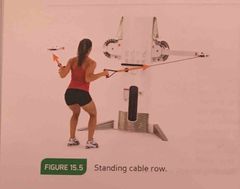
Back (Definition) |
|
|
|
Standing cable chest press : |
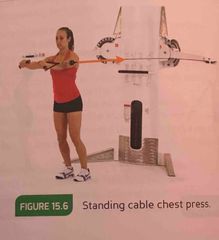
Back (Definition) |
|
|
|
Elastics resistance training can be used to help improve |
Proprioceptive demands, muscular endurance, & joint stabilization. |
|
|
|
Elastic resistance training has been shown to be very beneficial in helping to improve |
Muscular strength & endurance for fitness & rehabilitative purposes. |
|
|
|
Elastic resistance training techniques allow clients to move in |
Multiple planes of motion & often times achieve a greater ROM. |
|
|
|
Clients can adjust the angle of resistance (line of pull) during elastic resistance training by |
Moving the fixed point higher/lower, combining several exercises seamlessly. |
|
|
|
Elastic resistance training exercises allow clients to perform resistive exercises that mimic |
Sport specific movements (golf swing, tennis forehand). |
|
|
|
Rarely shut the elastic band be stretched longer then |
250% of its resting length. |
|
|
|
If the resistance provided by the elastic band is not sufficient, then the client will need to |
Progress to a thicker band or use 2 pieces of tubing of the same medium resistance. |
|
|
|
A thicker tubing will reach is elastic limit |
Sooner in the movement than thinner or medium thickness tubing. |
|
|
|
The amount of tension (resistance) from the start of tubing biceps curls compared with the end of a tubing biceps curl can |
Very significantly, meaning the tension (resistance) is not constant. |
|
|
|
Elastic resistance bands can be effectively used in what phases of the OPT model? |
Phases 1, 2, & 5. |
|
|
|
Elastic resistance may not be the ideal modality for individuals seeking |
Hypertrophy phase 3 or maximal strength phase 4. |
|
|
|
In phase 5 of the OPT model elastic tubing can provide resistance during |
Power exercises requiring explosive movement,(tubing speed squat). |
|
|
|
Tubing biceps curl : |

Back (Definition) |
|
|
|
Tubing speed squat : |

Back (Definition) |
|
|
|
Medicine balls are |
Weighted balls that come in an assortment of weights & sizes. |
|
|
|
Medicine balls date back to the |
Greeks in a Gyptian‘s, nearly 3,000 years ago. |
|
|
|
What are the “four horsemen of fitness”? |
Medicine balls, Indian club, the wand. |
|
|
|
Medicine balls can be used by |
Throwing, catching, providing a variety of movements, & a variety of planes of motion, at a variety of velocities. |
|
|
|
The ability to develop explosive power is one of the unique benefits of training with |
Medicine balls because the velocity of movement is critical to developing power. |
|
|
|
In an ideal training environment, maximal movement velocity should be obtained to increase |
Power capabilities, particularly for sports performance. |
|
|
|
When performing a nearly medicine ball chest pass, you can release the medicine ball at the |
End of movement, allowing for full concentric power development.. |
|
|
|
Medicine ball squats : |
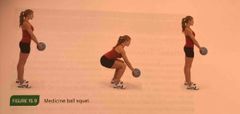
Back (Definition) |
|
|
|
Medicine ball push-ups : |

Back (Definition) |
|
|
|
Kneeling medicine ball chest pass : |
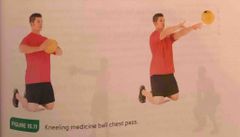
Back (Definition) |
|
|
|
High-velocity movements with medicinal balls will require a |
Lighter ball, generally less than 10% of an individual’s bodyweight. |
|
|
|
Rubber medicine balls are better for |
Rebound activities such as bouncing or throwing it against the wall. |
|
|
|
Assess your client, training environment, and their level of expertise with medicine ball training before implementing programs in which |
Medicine balls are thrown & caught. |
|
|
|
Kettle bells are |
Flat bottom cast iron balls with a handle. |
|
|
|
The kettle bell was first used as a unit of |
Measurement on market & farming scales. |
|
|
|
The kettle bell with them later used by the |
Russian military for conditioning & strength. |
|
|
|
The giyra, Russian for kettle bell, ranges from very low weight |
4 kg, over 8lbs, to competition style weight 64 kg, more than 140lbs, & higher weights exist. |
|
|
|
The kettle bell differs from a dumbbell, barbell, or medicine ball because the center of mass |
Is away from the handle, requiring more strength & coordination. |
|
|
|
Since the kettle bells center of mass is away from the handle it also requires |
An increased recruitment from stabilizers & prime movers simultaneously during particular. |
|
|
|
Weather using a two-handed, single-arm, hand-to-hand grip, or release-&-catch movement, the variety of positions and movement options allows for |
Increased skill Coordination NM control Dynamic strength Enjoyment |
|
|
|
All variations of the kettle bell allow the user to transform |
Dynamic force reduction into powerful force production. |
|
|
|
Weather using a two-handed, single-arm, hand-to-hand grip, or release-&-catch movement, the variety of positions and movement options of the kettlebell allows for |
Increased skill Coordination NM control Dynamic strength Enjoyment |
|
|
|
Weather using a two-handed, single-arm, hand-to-hand grip, or release-&-catch movement, the variety of positions and movement options of the kettlebell allows for |
Increased skill Coordination NM control Dynamic strength Enjoyment |
|
|
|
Benefits of kettle bell training include : |

Back (Definition) |
|
|
|
Kettle bell swing : two-arm |

Back (Definition) |
|
|
|
Benefits of kettle bell training include : |
Back (Definition) |
|
|
|
Kettle bell swing : two-arm |
Back (Definition) |
|
|
|
Injury may occur during kettlebell programs without inward |
Focus & conscious attention to technique. |
|
|
|
What are the 5 kinetic chain checkpoints for kettle bell use? |

Back (Definition) |
|
|
|
During kettlebell training practicing appropriate skills of the ___ & ___ must be ___. |
Gluteal & latissimus dorsi contraction Hollowing in bracing Continued & carefully progressed |
|
|
|
What are the 5 kinetic chain checkpoints for kettle bell use? |
Back (Definition) |
|
|
|
When using kettle bells it is safer to use a good quality |
Chalk to protect the hands, & to have plenty of space with rubber flooring or using an outdoor area. |
Exclude the use of gloves. |
|
|
A kettle bell exercise can be used in phase 1 to improve |
Stability in a renegade row. |
|
|
|
A kettle bell exercise can be used in phase 2 by |
Super setting the renegade row with a seated cable row. |
|
|
|
What are some examples of common bodyweight strength exercises? |
Push-ups, pull-ups, squats, sit ups. |
|
|
|
Bodyweight exercises are often used for |
Core Balance Plyometric training |
|
|
|
Kettle bell 5 kinetic chain checkpoints : |
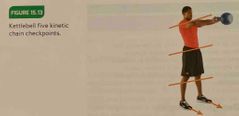
Back (Definition) |
|
|
|
Kettle bell renegade row : |

Back (Definition) |
|
|
|
Cable row superset with kettle bell renegade row : |

Back (Definition) |
|
|
|
Squat to OH superset with kettle bell snatch : |

Back (Definition) |
|
|
|
By performing body weight training exercises, individuals can learn how to train in |
All planes of motion & may require greater kinesthetic awareness. |
|
|
|
Closed chain exercises may result in greater |
Motor unit activation in synchronization when compared with open chain exercises. |
|
|
|
Closed chain exercises involve movement in which the |
Distal extremities (hands/feet) are in a constant fixed position (push-ups, pull-ups, squats) |
The ground or immovable objects |
|
|
Open chain exercises involves movement in which the |
Distal extremities (hands/feet) are not in a fixed position & the force applied by the body is great enough to overcome the resistance. (barbells, dumbbells, bench press, lap or down, machine leg extension) |
|
|
|
Open chain exercises involves movement in which the |
Distal extremities (hands/feet) are not in a fixed position & the force applied by the body is great enough to overcome the resistance. (barbells, dumbbells, bench press, lap or down, machine leg extension) |
|
|
|
Suspension trainers are unique training concepts that use |
Ropes & webbing. |
|
|
|
Suspension trainers are you need training concepts that allow personal trainers to |
Modify exercises to meet the needs of virtually any client by using their own bodyweight. |
|
|
|
Suspension movements are distinguished from traditional exercises in that either the user’s |
Hands/feet are supported by a single anchor point while the opposite end of the body is in contact with the ground. |
|
|
|
During suspension movements one end of the body is on the floor while the other end is supported by a single anchor, this enables the |
Loading &unloading movements to meet individual needs & goals. |
|
|
|
Suspension body weight training allows individuals to manipulate |
Body position & stability to provide multiplanar, multijoint exercises in a proprioceptively enriched environment. |
|
|
|
TRX suspension trainer : |
Back (Definition) |
|
|
|
Suspension movements are distinguished from traditional exercises in that either the user’s |
Hands/feet are supported by a single anchor point while the opposite end of the body is in contact with the ground. |
|
|
|
Stability balls are also known as |
Swiss balls |
|
|
|
During suspension movements one end of the body is on the floor while the other end is supported by a single anchor, this enables the |
Loading &unloading movements to meet individual needs & goals. |
|
|
|
Suspension body weight training allows individuals to manipulate |
Body position & stability to provide multiplanar, multijoint exercises in a proprioceptively enriched environment. |
|
|
|
Some of the physiological benefits that come with suspension body weight training include : |

Back (Definition) |
|
|
|
TRX suspension push-up : |

Back (Definition) |
|
|
|
Bench press superset with TRX suspension push-up : |

Back (Definition) |
|
|
|
Bench press superset with TRX suspension push-up : |
Back (Definition) |
|
|
|
Proprioception is defined as the |
Cumulative sensory input to the CNS from all McCanna receptors, which senses body position & limb movements. |
|
|
|
Improving the speed & quality of proprioceptive information enhances |
Motor learning & improve movement patterns & overall performance |
|
|
|
Popular proprioceptive modalities used within the fitness industry include |
Stability balls, Bosu balls, & whole-body vibration. |
|
|
|
The stability ball was popularized by |
Swiss physical therapist Dr. Suzanne Klein-Vogleback for adults with a variety of orthopedic problems. |
|
|
|
What are stability balls primarily made of? |
Polyvinylchloride (PVC) |
|
|
|
Stability balls are primarily used to increase the demand for |
Stability in an exercise, as well as to reinforce proper posture during squatting movements. |
|
|
|
Stability ball size chart : |
Back (Definition) |
|
|
|
Proper use of stability balls allows for increases in |
Strength & stability in the core musculature when substituted for more stable surfaces (benches, chairs, floor) |
|
|
|
The most popular use of a stability ball involves using it in place of traditional |
Benches during the performance of a variety of prone & supine exercises. |
|
|
|
Stability ball : Prone position : |
Back (Definition) |
|
|
|
Stability ball : supine position : |
Back (Definition) |
|
|
|
Stability ball : seated position : |
Back (Definition) |
|
|
|
Stability ball safety guidelines : |
Back (Definition) |
|
|
|
What are stability balls primarily made of? |
Polyvinylchloride (PVC) |
|
|
|
If the client can hold a prone iso-ab (plank) on a stable surface such as the floor or bench, a stability ball can |
Increase the difficulty & intensity of the exercise. |
|
|
|
Because of its vertical shape the stability ball, greater |
ROM can occur during certain exercises (stability ball crunches versus traditional crunches) |
|
|
|
Spinal extension, increasing abdominal strength. |
Spinal extension, increasing abdominal strength. |
|
|
|
For individuals with orthopedic limitations such as |
LBP, the ball allows for greater comfort & support during upright activities (ball wall squats). |
|
|
|
Stability ball prone Iso-ab : |
Back (Definition) |
|
|
|
Floor crunch versus stability ball crunch : |
Back (Definition) |
|
|
|
Ball wall squat : |
Back (Definition) |
|
|
|
The Bosu ball is an |
Inflated rubber hemisphere attached to a solid plastic surface. |
|
|
|
The name Bosu ball is an acronym for |
“Both sides up” referring to the ability to use a device either way. |
|
|
|
When the flat side is down, the dome offers a surface similar to a |
Stability ball, providing a stability challenge, yet stable enough to stand on. |
|
|
|
Stability balls are primarily used to increase the demand for |
Stability in an exercise, as well as to reinforce proper posture during squatting movements. |
|
|
|
When the dome is down, the hemisphere on the ground provides an |
Unstable surface with the flat bottom on top offering a platform the hands can be placed on to perform upper body exercises. |
|
|
|
Training with the BOSU ball offers the ability to increase |
The intensity of the exercise by decreasing the stability. |
|
|
|
Unlike the stability ball, the BOSU ball is relatively |
Safe to stand on, so it is a practical device to train with the target lower body balance & stability. |
|
|
|
Training while standing on an unstable surface has been found to increase |
NM activity which can increase balance, stability, & strength, particularly for injury prevention & during rehab. |
|
|
|
Stability ball size chart : |
Back (Definition) |
|
|
|
Proper use of stability balls allows for increases in |
Strength & stability in the core musculature when substituted for more stable surfaces (benches, chairs, floor) |
|
|
|
The most popular use of a stability ball involves using it in place of traditional |
Benches during the performance of a variety of prone & supine exercises. |
|
|
|
Stability ball : Prone position : |
Back (Definition) |
|
|
|
Stability ball : supine position : |
Back (Definition) |
|
|
|
Stability ball : seated position : |
Back (Definition) |
|
|
|
Stability ball safety guidelines : |
Back (Definition) |
|
|
|
Stability balls are best for clients who demonstrate a need for |
Increased overload of stability. |
|
|
|
What are stability balls primarily made of? |
Polyvinylchloride (PVC) |
|
|
|
If the client can hold a prone iso-ab (plank) on a stable surface such as the floor or bench, a stability ball can |
Increase the difficulty & intensity of the exercise. |
|
|
|
Stability ball size chart : |
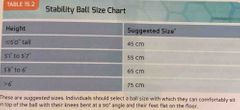
Back (Definition) |
|
|
|
Spinal extension, increasing abdominal strength. |
Spinal extension, increasing abdominal strength. |
|
|
|
For individuals with orthopedic limitations such as |
LBP, the ball allows for greater comfort & support during upright activities (ball wall squats). |
|
|
|
Stability ball : Prone position : |

Back (Definition) |
|
|
|
Stability ball : supine position : |
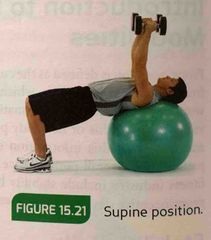
Back (Definition) |
|
|
|
Stability ball : seated position : |
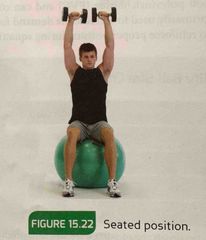
Back (Definition) |
|
|
|
Stability ball safety guidelines : |
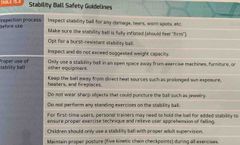
Back (Definition) |
|
|
|
The name Bosu ball is an acronym for |
“Both sides up” referring to the ability to use a device either way. |
|
|
|
When the flat side is down, the dome offers a surface similar to a |
Stability ball, providing a stability challenge, yet stable enough to stand on. |
|
|
|
Stability balls are primarily used to increase the demand for |
Stability in an exercise, as well as to reinforce proper posture during squatting movements. |
|
|
|
When the dome is down, the hemisphere on the ground provides an |
Unstable surface with the flat bottom on top offering a platform the hands can be placed on to perform upper body exercises. |
|
|
|
Training with the BOSU ball offers the ability to increase |
The intensity of the exercise by decreasing the stability. |
|
|
|
Stability ball prone Iso-ab : |
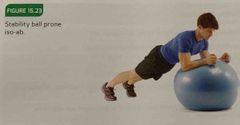
Back (Definition) |
|
|
|
Floor crunch versus stability ball crunch : |

Back (Definition) |
|
|
|
Ball wall squat : |

Back (Definition) |
|
|
|
Bosu ball push-up (flat surface) : |
Back (Definition) |
|
|
|
Because if it stabilization demands, Bosu balls are ideal modalities to use in phases |
1 & 2 of the OPT model. |
|
|
|
The ball super can be used in phase 1 for |
A BOSU ball OH press as your shoulder-stabilization exercise. |
|
|
|
You may use a BOSU ball in phase 2 by |
Supersetting a leg press with a BOSU ball squat |
|
|
|
You may use a BOSU ball in phase 5 by |
Doing a bench press superset with a BOSU ball plyometric push-up. |
|
|
|
Stability ball size chart : |
Back (Definition) |
|
|
|
Bosu ball shoulder press (round surface) : |
Back (Definition) |
|
|
|
Bosu ball squats (round surface) |
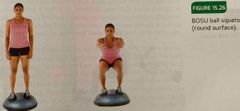
Back (Definition) |
|
|
|
Bosu ball push-up (flat surface) : |

Back (Definition) |
|
|
|
Proper use of stability balls allows for increases in |
Strength & stability in the core musculature when substituted for more stable surfaces (benches, chairs, floor) |
|
|
|
The most popular use of a stability ball involves using it in place of traditional |
Benches during the performance of a variety of prone & supine exercises. |
|
|
|
Stability ball : Prone position : |
Back (Definition) |
|
|
|
Stability ball : supine position : |
Back (Definition) |
|
|
|
Bosu ball shoulder press (round surface) : |
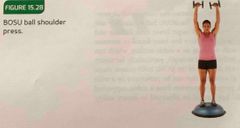
Back (Definition) |
|
|
|
Stability ball safety guidelines : |
Back (Definition) |
|
|
|
Bench press superset with BOSU ball plyometric push-up (round surface) : |

Back (Definition) |
|
|
|
What are stability balls primarily made of? |
Polyvinylchloride (PVC) |
|
|
|
If the client can hold a prone iso-ab (plank) on a stable surface such as the floor or bench, a stability ball can |
Increase the difficulty & intensity of the exercise. |
|
|
|
Stability ball size chart : |
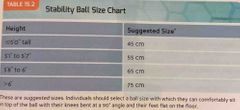
Back (Definition) |
|
|
|
Spinal extension, increasing abdominal strength. |
Spinal extension, increasing abdominal strength. |
|
|
|
For individuals with orthopedic limitations such as |
LBP, the ball allows for greater comfort & support during upright activities (ball wall squats). |
|
|
|
Stability ball : Prone position : |

Back (Definition) |
|
|
|
Stability ball : supine position : |
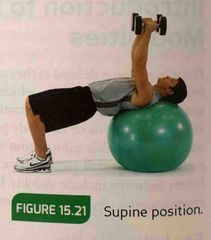
Back (Definition) |
|
|
|
Stability ball : seated position : |

Back (Definition) |
|
|
|
Stability ball safety guidelines : |

Back (Definition) |
|
|
|
The name Bosu ball is an acronym for |
“Both sides up” referring to the ability to use a device either way. |
|
|
|
When the flat side is down, the dome offers a surface similar to a |
Stability ball, providing a stability challenge, yet stable enough to stand on. |
|
|
|
Stability balls are primarily used to increase the demand for |
Stability in an exercise, as well as to reinforce proper posture during squatting movements. |
|
|
|
When the dome is down, the hemisphere on the ground provides an |
Unstable surface with the flat bottom on top offering a platform the hands can be placed on to perform upper body exercises. |
|
|
|
Training with the BOSU ball offers the ability to increase |
The intensity of the exercise by decreasing the stability. |
|
|
|
Stability ball prone Iso-ab : |
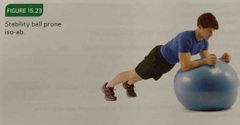
Back (Definition) |
|
|
|
Floor crunch versus stability ball crunch : |

Back (Definition) |
|
|
|
Ball wall squat : |

Back (Definition) |
|
|
|
Bosu ball push-up (flat surface) : |
Back (Definition) |
|
|
|
Because if it stabilization demands, Bosu balls are ideal modalities to use in phases |
1 & 2 of the OPT model. |
|
|
|
The ball super can be used in phase 1 for |
A BOSU ball OH press as your shoulder-stabilization exercise. |
|
|
|
You may use a BOSU ball in phase 2 by |
Supersetting a leg press with a BOSU ball squat |
|
|
|
You may use a BOSU ball in phase 5 by |
Doing a bench press superset with a BOSU ball plyometric push-up. |
|
|
|
Stability ball size chart : |
Back (Definition) |
|
|
|
Bosu ball shoulder press (round surface) : |
Back (Definition) |
|
|
|
Bosu ball squats (round surface) |
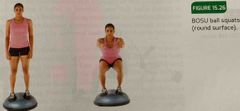
Back (Definition) |
|
|
|
Bosu ball push-up (flat surface) : |

Back (Definition) |
|
|
|
Proper use of stability balls allows for increases in |
Strength & stability in the core musculature when substituted for more stable surfaces (benches, chairs, floor) |
|
|
|
The most popular use of a stability ball involves using it in place of traditional |
Benches during the performance of a variety of prone & supine exercises. |
|
|
|
Stability ball : Prone position : |
Back (Definition) |
|
|
|
Stability ball : supine position : |
Back (Definition) |
|
|
|
Bosu ball shoulder press (round surface) : |
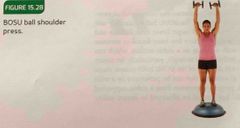
Back (Definition) |
|
|
|
Leg press superset with the BOSU ball squat (round surface) : |

Back (Definition) |
|
|
|
Bench press superset with BOSU ball plyometric push-up (round surface) : |

Back (Definition) |
|
|
|
Vibration training is more commonly referred to as |
Whole body vibration (WBV). |
|
|
|
WBV was developed by a |
Russian scientist in an effort to decrease the loss of muscle & bone mass of cosmonauts while in space. |
|
|
|
WBV training stimulates greater |
Muscle fiber involvement during exercise, leading to greater increases in lean body mass, weight loss, & change in body comp. |
|
|
|
Vibration training is more commonly referred to as |
Whole body vibration (WBV). |
|
|
|
WBV was developed by a |
Russian scientist in an effort to decrease the loss of muscle & bone mass of cosmonauts while in space. |
|
|
|
WBV training stimulates greater |
Muscle fiber involvement during exercise, leading to greater increases in lean body mass, weight loss, & change in body comp. |
|
|
|
Vibration training is typically performed on a |
Platform that generates (mainly) vertical sinusiodal vibrations (smooth repetitive oscillation). |
|
|
|
These sinusoidal vibrations stimulate |
Muscle contractions that are comparable to the tonic vibration reflex. |
|
|
|
Vibration training results in |
Strength increase similar to that of conventional resistance training. |
|
|
|
Rate of vibration |
Manipulation of frequency. |
|
|
|
Size of movement |
Amplitude |
|
|
|
The manipulation of frequency (rate of vibration) & amplitude (size of movement) creates what is known as |
Acceleration, which can be compared with gravitational (or g-) forces on earth |
|
|
|
Vibration training is more commonly referred to as |
Whole body vibration (WBV). |
|
|
|
By increasing mass (such as lifting a barbell or dumbbell), your body builds |
Strength to cope with the increase in force. |
|
|
|
Vibration training manipulates acceleration, creating an environment in which the body is stimulated to |
Increase strength as a result of higher g-forces, without the need for additional loads being placed on the musculoskeletal system. |
|
|
|
Positioning the body on the vibrating platform in a standing, kneeling, or lying position or when using accessory cables, causes a set of |
Chain reactions at different biological & physical levels. |
|
|
|
Power plate vibration platform : |
Back (Definition) |
|
|
|
Whole-body vibration exercise positions : |
Back (Definition) |
|
|
|
What are the different systems involved in the responses to vibration training? |
Bone and connective tissue NM Vascular Hormonal |
|
|
|
WBV was developed by a |
Russian scientist in an effort to decrease the loss of muscle & bone mass of cosmonauts while in space. |
|
|
|
WBV training stimulates greater |
Muscle fiber involvement during exercise, leading to greater increases in lean body mass, weight loss, & change in body comp. |
|
|
|
Vibration training is typically performed on a |
Platform that generates (mainly) vertical sinusiodal vibrations (smooth repetitive oscillation). |
|
|
|
These sinusoidal vibrations stimulate |
Muscle contractions that are comparable to the tonic vibration reflex. |
|
|
|
Vibration training results in |
Strength increase similar to that of conventional resistance training. |
|
|
|
Rate of vibration |
Manipulation of frequency. |
|
|
|
Power plate vibration platform : |
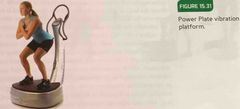
Back (Definition) |
|
|
|
Whole-body vibration exercise positions : |

Back (Definition) |
|
|
|
The force of gravity the body experiences is dependent on |
Mass (weight). |
|
|
|
Some of the favorable adoptions for individuals involved with vibrations are : |
Back (Definition) |
|
|
|
Power plate prone iso-ab (arms on vibration platform) |
Back (Definition) |
|
|
|
Barbell squat superset with power plate step-up to balance : |
Back (Definition) |
|
|
|
Power plate row superset with medicine ball soccer throw : |
Back (Definition) |
|
|
|
Prolonged exposure to intense vibration could be a |
Risk factor, (those working in industries such as transportation, construction, & the military) |
|
|
|
When muscles are already tensed, they will turn to |
Absorb vibrations better. |
|
|
|
Most vibration training programs require people to be |
Active (standing with semiflex knees on the platform) vs stationary (meaning the muscles are contracting, limiting transmission as a result of dampening) |
|
|
|
The risk is negligible when performing vibration training for a maximum ofVibration training should be used starting with |
30 minutes per session, 3X/ week. |
|
|
|
Vibration training should be used starting with |
Low intensity, low frequency settings & short session. |
|
|
|
The body should be gently stimulated in a way that will createWBZ in phase 1 you may perform a |
Adjustment but will not overwork thie system. |
|
|
|
WBZ in phase 1 the client may perform a |
Prone iso-ab (core-stabilization exercise) with your arms on the vibration platform. |
|
|
|
WBV in phase 1, the client may perform |
A barbell squat superset with a step-up to balance on the vibration platform. |
|
|
|
WBV in phase 5, the client might perform a |
Row using the platform cables superset with a soccer throw. |
|
|
|
Some of the favorable adoptions for individuals involved with vibrations are : |

Back (Definition) |
|
|
|
Power plate prone iso-ab (arms on vibration platform) |
Back (Definition) |
|
|
|
Barbell squat superset with power plate step-up to balance : |
Back (Definition) |
|
|
|
Power plate row superset with medicine ball soccer throw : |
Back (Definition) |
|
|
|
Prolonged exposure to intense vibration could be a |
Risk factor, (those working in industries such as transportation, construction, & the military) |
|
|
|
When muscles are already tensed, they will turn to |
Absorb vibrations better. |
|
|
|
Most vibration training programs require people to be |
Active (standing with semiflex knees on the platform) vs stationary (meaning the muscles are contracting, limiting transmission as a result of dampening) |
|
|
|
The risk is negligible when performing vibration training for a maximum ofVibration training should be used starting with |
30 minutes per session, 3X/ week. |
|
|
|
Vibration training should be used starting with |
Low intensity, low frequency settings & short session. |
|
|
|
The body should be gently stimulated in a way that will createWBZ in phase 1 you may perform a |
Adjustment but will not overwork thie system. |
|
|
|
Power plate prone iso-ab (arms on vibration platform) |
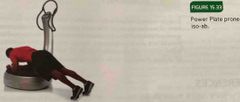
Back (Definition) |
|
|
|
Barbell squat superset with power plate step-up to balance : |

Back (Definition) |
|
|
|
Power plate row superset with medicine ball soccer throw : |

Back (Definition) |
|

